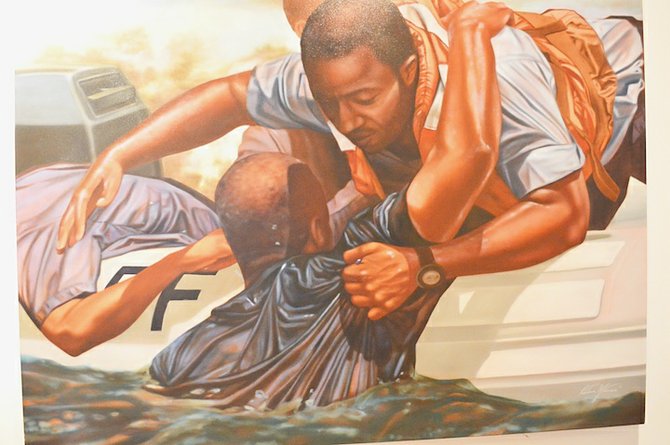By NOELLE NICOLLS
Tribune Features Editor
nnicolls@tribunemedia.net
THE streets of Old Havana, Cuba come alive with the sounds of salsa; the pulse of the drums and the rhythmic vibrations of the guitars beckon pedestrians into the bars and restaurants along the main strip. About four years ago, I exited one of those bars and stumbled onto Kishan Munroe, a mysterious Bahamian photographer, painter and all-around visual artist, whose epic project, “The Universal Human Experience”, I was vaguely familiar with and highly intrigued by.
Secretly I wanted to know, ‘Why was Kishan in Cuba?’
Bahamians usually have a secret agenda when they visit Cuba; it’s more than the pure ambition to experience the place that mojito-sipping tourists display. Take for example the Bahamian men who are said to frequent Cuba on the ‘down low’ to enjoy the more erotic side of the culture, or the Bahamians who travel for medical reasons because they believe in the superiority of Cuban treatment. For Bahamians, there is usually something beyond the natural curiosity people have for the communist country that drives them to set foot on the island.
Kishan and I never swapped stories about the missions that led our paths to cross. And there is no need now. All has come to light. Kishan was on yet another career-defining journey, digging into the secrets of Cuba’s past relationship with the Bahamas.
In keeping with his mission to tell the story of conflict and conflict resolution throughout the human experience, Kishan turned his creative imagination to a tragedy that will forever tie the Bahamas and Cuba together: the deaths of four Bahamian marines and the sinking of the Royal Bahamas Defence Force HMBS Flamingo by Cuban fighter jets on May 10, 1980.
Kishan interviewed some of the 15 men who survived the ordeal, as well as other public figures connected to the vigorous diplomacy effort that eventually led to a mutual resolution. Cuba accepted responsibility and paid $10 million in reparations, and the eight poachers, who instigated the conflict after being caught with 3,000 pounds of fish, conch, stone crab and lobster in Bahamian territorial waters, were convicted and fined $90,000.
Inside Cuba, the story of the HMBS Flamingo sits inside the classified files with other relics of the Cold War. Kishan journeyed from Havana in the north to Baracoa in the south and found not one Cuban who knew about the incident. And yet, in good faith, the Cuban government unleashed Kishan on its streets to explore the complex relationship between the two nations as only an artist can do. Kishan worked for more than three years to create an exhibition that would commemorate the sinking of the HMBS Flamingo, generate dialogue about the incident’s wider significance and highlight the contemporary joys and pains of the Bahamas’ relationship with Cuba.
On Thursday, November 21, the National Art Gallery of the Bahamas will open “Swan Song of the Flamingo”, a multi- disciplinary solo exhibition by Kishan Munroe, who is the youngest Bahamian to be granted the honour.
Unlike some expressions of art that can devolve into mere exercises in vanity, the “Swan Song of the Flamingo” is a redemptive tribute to the complex and curious relationship between the Bahamas and Cuba that aims to truly bring meaning to the notion of cultural exchange.
“Swan Song of the Flamingo” is a collaborative project, although it is dominated by Kishan’s 20 large-scale paintings, averaging five by six feet. All of the paintings are charged with emotion: the harrowing silence of the hopeless and the earnest effort of the determined.
Flamingos, symbols of grace, solidarity and Bahamian independence are ever present in the work, whether as a pink stain covering the ocean, a mirror to the affliction of men, or the celestial embrace of angels. In one of the paintings, the inaudible screams of two mangled flamingos are juxtaposed with the quiet resolve of a stranded seaman.
Leading Bahamian and Cuban artists from various mediums collaborated with Kishan, including Cuban dancers Eduardo Blanco, Amaya Rodriquez and Bahamian musical legends JoAnn Callender, Cleophas Adderley and Lee Callender.
Kishan’s visual artistry is married to the intellectual vigour of Patricia Glinton Meicholas, whose new history book, “The Sinking of HMBS Flamingo and Its Roots in United States, Cuba and Bahamas Relationships”, was specifically written in support of the project.
According to the author, the book “collates more of the details of the Flamingo incident and its aftermath than had been attempted previously. It also advances a theory as to why the Cubans attacked on May 10, 1980, something no other work has examined in any detail previously.”
Munroe also recruited Obediah Michael Smith and Sonia Farmer to lend their poetic accounts to the storytelling. And he enlisted Gavin McKinney, famed underwater photographer, to create dramatic images for a documentary that is currently in production.
Kishan also worked closely with the Royal Bahamas Defence Force, a relationship he worked on for one year before it was consummated.
In the past, the commemoration of the tragedy of the HMBS Flamingo has mainly been the concern of Defence Force officers, public officials and the families of those involved. Kishan’s mixed media account of this moment in history will no doubt make the story accessible and contextual for many more Bahamians and bring about renewed dialogue and analytical investigation into the wider meaning of the incident.





Comments
Use the comment form below to begin a discussion about this content.
Sign in to comment
Or login with:
OpenID